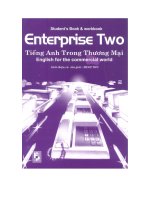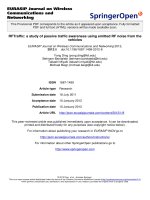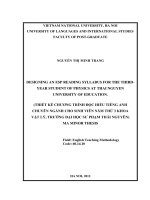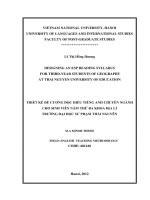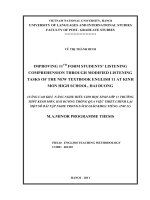using driving questions adapted from the requirements of some speaking tasks in the new textbook “tieng anh 10” to encourage students active participation in speaking activitie
Bạn đang xem bản rút gọn của tài liệu. Xem và tải ngay bản đầy đủ của tài liệu tại đây (4.8 MB, 53 trang )
NGHE AN DEPARTMENT OF EDUCATION AND TRAINING
––––––––––––––––––––––––
USING DRIVING QUESTIONS ADAPTED FROM THE
REQUIREMENTS OF SOME SPEAKING TASKS IN THE NEW
TEXTBOOK “TIENG ANH 10” TO ENCOURAGE STUDENTS’
ACTIVE PARTICIPATION IN SPEAKING ACTIVITIES
Subject: English
Vinh, 2021
NGHE AN DEPARTMENT OF EDUCATION AND TRAINING
LE VIET THUAT HIGH SCHOOL
USING DRIVING QUESTIONS ADAPTED FROM THE
REQUIREMENTS OF SOME SPEAKING TASKS IN THE NEW
TEXTBOOK “TIENG ANH 10” TO ENCOURAGE STUDENTS’
ACTIVE PARTICIPATION IN SPEAKING ACTIVITIES
Subject:
English
Researcher:
Vo Thi Thuy Linh
Group: Literature – Foreign languages
Vinh, 2021
TABLE OF CONTENTS
CONTENTS
PAGE
PART I: INTRODUCTION
1
1. Rationale
1
2. Aims of the Study
2
PART II: CONTENT
3
I. THEORETICAL BACKGROUND
3
1. Project-based learning
3
2. Driving questions as a key feature of project-based learning
3
2.1. Function of driving questions
3
2.2. What makes a good driving question?
4
2.3. Common types of driving questions
4
3. Speaking skills
4
3.1. Definition of speaking
4
3.2. The elements of speaking
4
4. Adapting Textbooks
5
4.1. What is textbook adaptation?
5
4.2. Principles and techniques for adapting textbooks
5
4.3. Instructions for adapting textbooks
6
II. PRACTICAL BACKGROUND
7
1. An overview of the new textbook “Tieng Anh 10”
7
2. Situation of teaching and learning speaking skills at high school
7
III. THE STUDY
8
1. Methodology
8
1.1. Participants
8
1.2. Instrumentation
8
1.3. Data collection procedures
8
2. Findings of the study
9
3. Finding solutions
9
3.1. Suggested adaptations for the requirements of some speaking tasks
in the new textbook “Tieng Anh 10”
9
3.2. Sample teaching plans
20
4. Results and Discussion
35
PART III: CONCLUSION
36
1. A summary of the development of the study
36
2. Limitations
36
3. Recommendations
36
REFERENCES
APPENDICES
PART I: INTRODUCTION
1. Rationale
It is irrefutable that the English language has gained more and more
significance in every aspect of society in general and in education in particular.
Realizing the importance of English in education, many policies and renovations
have been promulgated in teaching and learning English during the recent years.
In an attempt to innovate Vietnamese education to meet the demand of the
society in the process of integration and development, the Vietnamese Ministry
of Education and Training has reformed English textbooks since the school year
2020-2021. With this reform, both teachers and students have certain advantages
and disadvantages in mastering the four skills in the process of teaching and
learning English.
Of the four skills, speaking, in general, is considered a relatively difficult
one for students to master. Students of low-proficiency level consider speaking
as a challenging skill to fulfill effectively. When practising speaking skills, the
students tend to translate the ideas from their mother tongue into English, which
makes them confused in using words, grammatical structures and organizing the
ideas. Moreover, because of limited background knowledge as well as essential
skills, they often feel bored when carrying out speaking tasks, especially when
lacking support and motivation from teachers. Due to students’ low level of
proficiency, time constraints and low motivation, speaking skills still remain
neglected in upper-secondary schools and teaching speaking skills is a
challenging job for many teachers.
In addition, most speaking activities in the upper-secondary syllabus in
general, and in the new textbook “Tieng Anh 10” in particular, are designed in a
controlled speaking format. All the students have to do is following the activities
given in the book under the instructions of teachers. This, to some extent,
demotivates students because they cannot use their own experiences to express
themselves and hinders teachers from applying new approaches in teaching
speaking.
Besides, from the experience in teaching speaking skills to the 10 th form
students who have a rather low level of proficiency in learning English, the
author realizes that some of the students do not have so much interest in
speaking classes as in classes of other skills. They have certain difficulties in
performing the required speaking tasks in the textbook by themselves.
Related to these problems, this study was carried out, entitling: Using
driving questions adapted from the requirements of some speaking tasks in
the new textbook “Tieng Anh 10” to encourage students’ active participation
in speaking activities.
1
2. Aims of the Study
The study aims at suggesting adaptations of driving questions designed
from some speaking task requirements given in the new textbook “Tieng Anh
10” to motivate 10th graders to participate actively in speaking activities in class.
2
PART II: CONTENT
I. THEORETICAL BACKGROUND
1. Project-based learning
Projects are defined as complex tasks, based on challenging questions or
problems, that involve students in design, problem-solving, decision making, or
investigative activities; give students the opportunity to work relatively
autonomously over extended periods of time; and culminate in realistic products
or presentations. Students in a project-based classroom take part in different
activities, namely investigating questions, proposing hypotheses and
explanations, discussing their ideas, challenging the ideas of others, and trying
out new ideas.
Definitions of project-based learning include features relating to the use of
an authentic ("driving") question, a community of inquiry, and the use of
cognitive (technology-based) tools (Krajcik et al, 1994).
2. Driving questions as a key feature of project-based learning
2.1. Function of driving questions
The driving question in project-based learning serves to organize and
drive activities of the project, provides a context in which students can use and
explore learning goals and scientific practices, and provides continuity and
coherence to the full range of project activities.
Learning environments that are project-based have five key features
(Blumenfeld et al., 1991; Krajcik, et al., 1994):
1. They start with a driving question, a problem to be solved.
2. Students explore the driving question by participating in authentic, situated
inquiry – processes of problem solving that are central to expert performance in
the discipline. As students explore the driving question, they learn and apply
important ideas in the discipline.
3. Students, teachers, and community members engage in collaborative activities
to find solutions to the driving question. This mirrors the complex social
situation of expert problem solving.
4. While engaged in the inquiry process, students are scaffolding with learning
technologies that help them participate in activities normally beyond their
ability.
5. Students create a set of tangible products that address the driving question.
These are shared artifacts, publicly accessible external representations of the
class’s learning.
3
2.2. What makes a good driving question?
Some factors that should be considered in writing driving questions include:
- Make the question engaging. The best questions are easily understood and
interesting. They ignite curiosity, making students eager to explore answers.
- Craft open-ended questions. Driving questions go beyond fact-finding and
reporting. They require students to compile information and use application,
analysis, evaluation and synthesis to arrive at answers. Yes-no questions do not
require critical thinking.
- Support student learning goals. Projects are based on the content and skills
students must learn. The driving questions align with these goals and incorporate
academic vocabulary.
2.3. Common types of driving questions
Following are some common types of driving questions that are suitable for high
school students.
- Solve a Problem: There’s a real-world predicament with multiple solutions.
- Educate: The purpose of the project is to teach others.
- Convince Others: Students persuade a specified audience to do something or
change their opinions.
- Discuss Broad Theme: The project tackles big ideas.
- Give Opinion: Students need to consider all sides of an issue in order to form
and justify their opinions.
3. Speaking skills
3.1. Definition of speaking
Speaking is a basic skill that language learners should master with the
other language skills. It is defined as a complex process of sending and receiving
messages through the use of verbal expressions, but it also involves non-verbal
symbols such as gestures and facial expressions. Hedge (2000: 261) defines
speaking as “a skill by which people are judged while first impressions are being
formed.”
3.2. The elements of speaking
In order to speak a foreign language fluently and accurately, learners need
to be able to know some elements which are very important to develop this skill.
4
According to Harmer (2001:89), these elements include knowledge of
vocabulary, grammar, fluency and also attitude. These are the main cores of
speaking that have to be learned by the learner who are willing to learn foreign
language.
4. Adapting Textbooks
4.1. What is textbook adaptation?
Adapting textbook activities is not just something teachers should do as
the need arises but also for appealing to the lower, middle and strong student
levels. Textbook adaptation is performed to make textbook lessons more
communicative and incorporate authentic textbook into the lessons. Adapting is
the ability to create the textbook that introduces and integrates skills in a lively,
enjoyable and productive format.
4.2. Principles and techniques for adapting textbooks
Despite the great effort that textbook writers make to meet the needs of
the intended users, textbooks are subject to adaptation when they are actually
used in the classroom. McDonough and Shaw (1993:83) propose that textbooks
are internally coherent although they may be, they may not be entirely
applicable. Although most classroom teachers will not be involved in the
production of textbooks, all teachers have the responsibility for textbook
evaluation, selection and adaptation. It is undeniable that adapting textbook
allows teachers to achieve more compatibility and fitness between the textbook
and the teaching environment, and therefore maximize the value of the book for
the benefit of their particular learners and for the most effective teaching
outcomes to achieve. Maley (1998:281) suggested the following techniques to
adapt textbook:
• Omission: the teacher leaves out things seemed inappropriate, offensive,
unproductive, etc., for the particular group.
• Addition: where there seems to be inadequate coverage, teachers may
decide to add to textbooks, either in the form of texts or exercise material.
• Reduction: where the teacher shortens an activity to give it less weight or
emphasis.
• Extension: where an activity is lengthened in order to give it an additional
dimension. (For example, a vocabulary activity is extended to draw attention to
some syntactic patterning.)
• Rewriting/modification: teacher may occasionally decide to rewrite
material, especially exercise material, to make it more appropriate, more
“communicative”, more demanding, more accessible to their students, etc.
5
• Replacement: text or exercise material which is considered inadequate, for
whatever reason, may be replaced by more suitable material. This is often culled
from other resource textbook.
• Re-ordering: teachers may decide that the order in which the textbooks are
presented is not suitable for their students. They can then decide to plot a
different course through the textbooks from the one the writer has laid down.
• Branching: teachers may decide to add options to the existing activity or to
suggest alternative pathways through the activities.
Textbook adaptation can be done at three levels. The first level is macro
adaptation, which is ideally done before the language program begins. After
comparing what is covered in a textbook and what is required by the syllabus or
examination, the teacher may find that certain areas or even whole units of the
book can be omitted, and certain contents need to be supplemented.
The second level of adaptation is adapting a unit. This could be done by
reordering the activities, combining activities, omitting activities, rewriting or
supplementing exercise material, etc. Unit adaptation helps to make the
classroom teaching more smooth and cohesive. It also helps the teacher to better
fulfill the aims of a unit.
The third level is adaptation of specific activities in a unit. Occasionally
an activity is regarded as valuable, but it is not well-designed or it is not suitable
in a particular class. If the teacher does not want to give up the activity, he or she
needs to adapt it.
4.3. Instructions for adapting textbooks
When adapting the textbooks, teachers should follow the following steps:
1. Decide what content or which topics need adapting in light of the reading
texts and activities. Activities can relate to any one of the four basic skills:
reading, listening, writing and speaking. Can the text be exploited because of it
thematic, lexical and structural elements in order to appeal and engage all three
levels of students? If not, you will need to adapt your textbook activities to suit
the levels. This may appear as a ton of work, but the key is to think better, not to
work harder.
2. Before you go ahead and change some of the activities particularly the
reading activities, consider rewriting parts or all of the texts. The reason for
doing this is to simplify some of the vocabulary items and other concepts that
might be difficult for some of your low-performing ESL students to understand.
You might also consider glossing the difficult vocabulary items or writing the
meanings in another language if you are teaching in a bilingual context.
3. Take a look at those textbook activities in your textbooks and redesign
them in light of the amount of the activity itself. Redesigning the activity in light
6
of "amount" is about the obligatory and optional tasks. ESL students can be
required to complete a specific amount of questions. For example, lowperforming ESL students can list four answers, while the stronger students can
list more than four answers.
4. Cater to the level of difficulty of the task. The teacher can adapt the task
to suit all three levels: lower, middle and stronger. This gives the student a
choice of activities. Most ESL students will want to choose first the activity that
they feel they can comfortably do before deciding if the topic is motivating
enough. Again, adapt the language of the activity and the instructions of the
activity itself to suit the level of the student's linguistic ability.
5. Decide how you want to engage your students. If you are working with
groups, then maybe you should adapt a few textbook activities to engage
students in group or pair work. Once you have decided how you want to actively
engage your students, you will need to make sure students understand the
procedures of group and pair work you intend to use. Leave enough time in the
lesson to do both or you will find yourself struggling with time.
(retrieved from />II. PRACTICAL BACKGROUND
1. An overview of the new textbook “Tieng Anh 10”
Each unit in the textbook “Tieng Anh 10”, which refers to a particular
theme, is divided into 6 sections: Getting started, Language, Skills,
Communication and Culture, Looking back and Project. Each section is
designed with different kinds of activities with a view to helping students follow
the lessons easily and attain basic knowledge related to the theme of the unit as
well as improve their skills in terms of Reading, Speaking, Listening and
Writing. Normally, each skill lesson is taught and learnt in a 45-minute period.
Like other skill lessons presented in the textbook, speaking lesson
consists of many activities from the easier to more complicated ones for students
to fulfill.
2. Situation of teaching and learning speaking skills at high school
Under the instructions of Ministry of education and training, all schools
now have had their own syllables for teaching and learning English. As far as I
know, most high schools in Nghe An province allot 45 minutes for each skill
lesson. However, many of the activities in Reading, Listening and Writing
lessons in general and in Speaking lesson in particular are not fully carried out
due to the lack of time as well as students’ uneven levels of proficiency. Many of
the students are not able to actively take part in pair or group discussions due to
7
their capability. However, another factor affecting the quality of the speaking
lesson lies in the monotonous requirements of some tasks given in the textbook.
Taken these factors into consideration, it is undeniable that the objective of the
lesson is not always reached. Because of these reasons, I would like to suggest a
number of adaptations for the requirements of some speaking lessons to make
speaking activities easier for students to fulfill so that the lesson objective is
fully gained.
III. THE STUDY
1. Methodology
1.1. Participants
The participants of the research consist of 90 students of 10 th form from
classes 10A and 10D at Le Viet Thuat high school. In this study, no students
were identified by their names. All of the informants have the same time of
learning English of five years; and they have already completed the syllabus of
English with the new series of English textbook from grade 6 to grade 9 at
secondary school.
1.2. Instrumentation
In order to get information to fulfill the aims of the study, a survey
questionnaire (given in Appendix 1) was designed and delivered to the student
respondents. The survey questionnaire included two parts: Part 1 was some
personal information and Part 2 comprised 5 questions relating to researched
issue. Questions in the questionnaire contained both closed-ended questions and
opened-ended questions. The questionnaire was written in a logical order so that
they could gradually lead the respondents into the theme of the study and
stimulate the respondents to the questions.
In addition, students’ presentation results in speaking classes were used to
evaluate the effectiveness of the application of the study.
1.3. Data collection procedures
The quantitative method was mainly used in the study. A survey through
questionnaire was conducted among the participants with a view to gathering
students’ opinions on learning speaking in class. The participants were asked to
answer all of them honestly and frankly. All of these answers would be used as
important data of the study.
The participants, then, were divided into two groups, one was taught with
the application of the intended driving questions while the other was not.
After the two groups had completed their study with different teaching
methods (with and without using driving questions), they were asked to make a
8
presentation on the same topic to get marks. The data gained from the
questionnaire along with the results of students’ presentations in class were used
to evaluate the effectiveness of the application of adapted driving questions.
2. Findings of the study
The results from the survey show that a majority of the participants
(72,2% ) regard speaking as the most important skill in learning English. The
second position is listening skill, which accounts for 14,4% of the informants.
Reading skill holds the third most important place with 9%. Meanwhile, only
4,4% of students evaluate writing skill important.
However, despite this evaluation most of the students do not like speaking
skills. 77 out of 90 respondents reveal that they are not interested in speaking
lessons they have in class. This is explained through their comments on the
factors that affect their interest in learning speaking skills. 52% of the students
who do not like speaking claim that their disinterest in learning speaking skills
lie in the requirements of the textbook and the teacher. These students think that
the instructions of the tasks are not motivating and they do not want to be asked
to follow exactly the activities presented in the textbook. Another factor which
has bad influence on students’ preference for learning speaking skills is their
personal problems like shyness. 28,6% of students in this group admit that their
lack of confidence and shyness prevent them from taking part in speaking
activities. Approximately 19,4% of the students complain about vocabulary and
grammar structures in speaking activities, which proves that students to some
extent are able to master basic things of a speaking activity. It is also surprising
to discover that none of the students dislikes English as well as speaking topics
in the textbook. One more significant finding related to students of this group is
that nearly all of them feel embarrassed, nervous, uncomfortable and even bored
when taking part in speaking activities.
On the contrary, the rest of the respondents (13 students) find their
speaking lessons interesting. All of them agree that the factors encouraging them
to learn speaking include teacher’s teaching method, chances of speaking
English more and improving speaking skills, no new structures, and fascinating
activities given in the textbook. Students of this group also feel confident and
motivated with speaking activities in class.
From these findings, I would like to make some suggestions on changing
the requirements of some speaking tasks in the new textbook in order to
facilitate students’ process of actively taking part in speaking activities, hence
enhance their speaking skills.
3. Finding solutions
3.1. Suggested adaptations for the requirements of some speaking tasks in
the new textbook “Tieng Anh 10”
9
Unit 1: Family Life
Speaking lesson objective: exchanging opinions about household chores
10
a. Comments:
It can be seen that despite familiar topic, three activities in this speaking
lesson do not really help students improve their speaking skills.
What students need to do with activity 1 is listing and filling in the table
with their own information. Activity 2 requires students to match the exchanges
and practise reading them. Thus, students do not have chance of practising
speaking skills from these two activities. Although activity 3 allows students to
practice asking and answering questions about the chores they like or dislike
supported by relevant reasons, students may feel bore when doing this pair work
as their reasons can be repeated. Therefore, personally I believe that the
requirements of the given activities should be modified so that students can get
involved in more speaking activities.
b. Suggestions:
I would like to suggest two driving questions which can be applied into
this lesson with a view to engaging all students in carrying out the activities.
They are presented with expected outcomes as well as suggested work
arrangement for each activity.
Question 1: Which household chores Question 2: How can students
do you like and dislike doing? Give arrange time to do the housework?
reasons for your answer.
Present your discussion.
- work arrangement: individual work, - work arrangement: group work
pair work or group work.
- possible outcomes:
- possible outcomes:
+ students think of the way they
+ students make a list of the chores arrange time to do household chores.
they do (as required in activity 1).
+ students share their ideas with the
+ students talk about their likes and group.
dislikes (as required in activity 2).
+ students discuss and choose ideas for
+ students explain for their preferences their group’ presentation.
(as required in activity 3).
+ the representative presents the
groups’ discussion.
These questions not only guarantee the objective of the lesson but also
motivate students, even students of average proficiency, to talk since they relate
students to their real experience at home.
11
Unit 2: Your body and You
Speaking lesson objectives: talking about how to get rid of bad habits
12
a. Comments:
There are 4 activities in the speaking lesson, which is difficult for both
teachers and students to complete them in 45 minutes. In addition, basing on the
lesson objectives, there are overlaps among these activities. Activities 1 and 2
can be combined by having students explain their answers at the same time they
choose the habits so as to save time for other activities. According to the lesson
objectives, it is also unnecessary for students to answer the given questions in
activity 3. This activity should be a reference for students to carry out the
following one.
b. Suggestions:
From the above analysis, I would like to suggest following driving
questions to make it more suitable for large classes with students at different
levels of proficiency.
Question 1 (for activities 1 and 2): Question 2 (for activities 3 and 4):
Which of the following habits do you Choose one bad habit and suggest
have and how do they affect you?
some ways to kick it. Use information
in activity 3 as a reference if
necessary.
- work arrangement: individual work, - work arrangement: pair work or
pair work or group work.
group work.
- possible outcomes:
- possible outcomes:
+ students think of their own habits.
+ students make a list of Dos and
+ students can identify which habits Don’ts (as required in activity 4).
are good or bad for them (as required + students add ideas in activity 3 to
in activity 1).
their talk.
+ students talk about the effects of + students share their own experience
these habits on them.
to complete their talk.
+ students explain their identification
of good and bad habits (as required in
activity 2)
In brief, driving questions in this case ensures the lesson objectives as
well as suitable time for a speaking lesson in 45 minutes, especially in large
classes.
13
Unit 3: Music
Speaking lesson objectives: talking about TV shows
14
a. Comments:
There are only two activities for this lesson, which seems appropriate for
the time within a speaking lesson. However, their requirements do not create
many opportunities for students to practise speaking skills. As a result, the
activities to some extent are unappealing to students. If students follow exactly
the requirement of activity 1, all they have to do is completing the table with
given information. Although they are asked to compare and contrast the
information with a partner, some do not need to speak English to do this. They
may exchange their writings and write feedback on their partners’. Similarly,
students can create a new show like the example in activity 2a by themselves
without any difficulties and with no discussion if they follow the given
requirements.
b. Suggestions:
In order to solve these problems, the requirements of the activities should
be modified into more stimulating ones for students to carry out. With this
lesson, I would like to make some changes by raising another question for
activity 1.
Driving question 1: Read the TV Driving question 2: Create a new TV
blurbs in the textbook, then make a show and describe it in details to the
similar one to introduce about your class.
favourite TV show and present it to
the class.
- Work arrangement: individual work - Work arrangement: pair work or
or pair work
group work
- Possible outcomes:
- Possible outcomes:
+ students read the TV blurbs given in + students can use their imaginative
the textbook (as required of activity 1). ideas to create a TV show and share it
+ students know what kind of with their friends.
information included in a TV blurb + students can improve their
with no need of writing down as presentation skill by talking about the
required.
show they have created.
+ students talk about the TV show they
like.
In one word, changing the requirements in this lesson helps students have
more opportunities to practise speaking skills.
Unit 6: Gender Equality
15
Speaking lesson objectives: exchanging opinions about equal job opportunities
for men and women
16
a. Comments:
There are three activities for students to carry out in this part. The first
activity provides students with useful expressions of showing agreement or
disagreement. However, because of its requirement, the second activity is
separated from the main one (activity 3) in terms of cohesion and idea relation
while some statements in activity 2 (statements 1,3,4,6) can be helpful for
students to fulfill the requirements of the next activity. Moreover, there is a
repeat of ideas between activities 2 and 3. The second and the third statements of
activity 2 to are equivalent to the first and the third statements of activity 3
respectively.
b. Suggestions:
To make full use of the ideas provided in activities 2 and 3, I would like to
combine them into one with an expansion of the given requirements. By doing
this students who have difficulty in brainstorming ideas for their discussion will
find it easier to carry out the speaking task. Besides, another driving question is
designed not only to encourage students to speak using their own understanding
and experience but to raise their awareness of gender equality in job
opportunities in modern society.
Driving question 1: Discuss if you
agree or disagree with the following
statement “Married women should
not pursue a career”, using sentences
in 2 and 3 and your own ideas for
your agreement or disagreement.
Report the results of your discussion
to the class.
Driving question 2: What should the
husband in modern society do to help
his wife if she wants to pursue a
career?
- Work arrangement: pair work or - Work arrangement: individual work,
group work
pair work or group work
- Possible outcome:
- Possible outcomes:
+ students use sentences in the book + students can relate this question to
(activities 2 and 3).
their family situations and share ideas.
+ students use their own ideas.
+ students discuss and make a list of
+ students use expressions of things that a husband should do to
agreement or disagreement in activity share housework with his wife so that
she has time to pursue her career.
1.
+ students can be aware of the equality
in job opportunities and household
responsibilities between men and
women.
17
Unit 7: Cultural diversity
Speaking lesson objectives: comparing traditions and customs in different
countries and discuss those in Viet Nam.
18
19
a. Comments:
There are four activities in the speaking lesson. Activities 1 and 4 are
suitable for different students to carry out. According to the requirements of
activities 2 and 3, each student only has to get information about either the UK
or Russia. Therefore, it may causes difficulties for students of lower proficiency
to have a complete understanding about the content of two passages when they
practice speaking with different partners as required in activity 3. They may not
be able to exchange their ideas with other students due to their limited
vocabulary unless they have read the passages beforehand. As a result, it may
take a lot of time to complete these two activities.
b. Suggestions:
In order to have all students involve in these activities in an active and
effective way, and to save time for other activities, I propose that requirements
should be changed to make them more suitable for students’ capabilities.
My suggested driving question is: Read about the traditions and customs
in the UK and Russia, then compare these things in two countries. Report
your findings to the class.
- Work arrangement: pair work or group work
- Possible outcomes:
+ students know about some traditions and customs in the UK and Russia.
+ students discuss and find out the similarities and differences in these traditions
and customs.
+ students can improve their speaking skills through presenting their discussion
results.
3.2. Sample teaching plans
The following are sample teaching plans that I have used in my teaching
for one group of the respondents. While applying them into the lesson, I am
happy to realize that most of the students are much eager to get involved in
carrying out all the activities required.
Sample teaching plan for Unit 1: Family life- part B: Speaking
Time: 45 minutes
I. Objectives:
By the end of this lesson, students can
1. Knowledge:
20
- use lexical items related to the topic Family Life
- exchange opinions about household chores
2. Skills:
- speak to exchange opinions about household chores
3. Attitude:
- willingly acquire and exercise the tasks
- actively, creatively and cooperatively participate in and fulfill assigned tasks
- positively, confidently take part in discussing and presenting the result of the
tasks during lessons
- build up and develop love and responsibility for family
- be ready to do take actions to do the duties in the family
4. Competences need to develop:
- pair work and group work skill
- communicative competence
- creative competence
II. Preparations:
- Teacher: textbook, laptop, projector
- Students: Textbook
III. Procedures:
Time/Stages
Activities
1. Warm up
Activity: Brainstorming
5 minutes
The purpose of this activity is to stimulate Ss before
studying and revise some phrases of household
chores they have learnt.
Interactions
Individual
work +
T <--> Ss
- Ask Ss to make a list of household chores
cooking
washing up
Household chores
sweeping
doing the laundry
21

